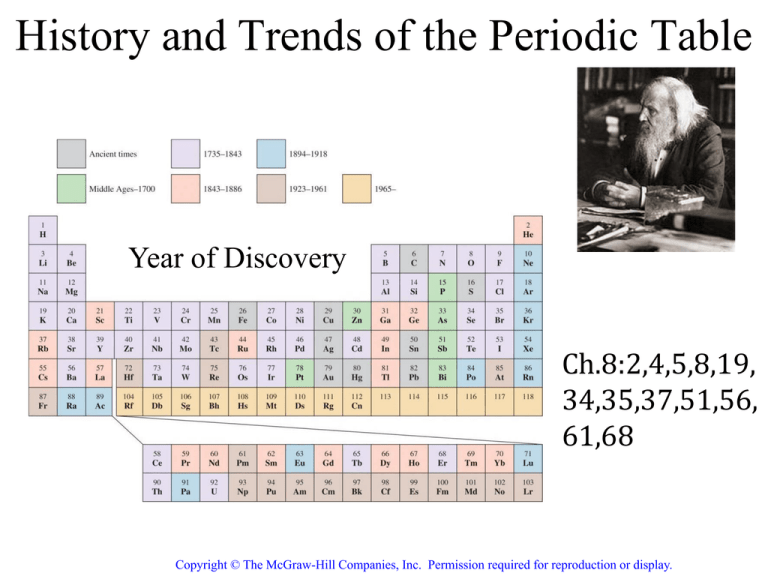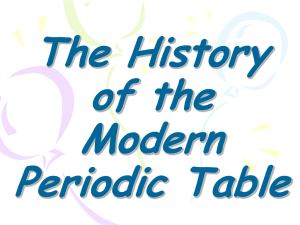File
advertisement

History and Trends of the Periodic Table Year of Discovery Ch.8:2,4,5,8,19, 34,35,37,51,56, 61,68 Copyright © The McGraw-Hill Companies, Inc. Permission required for reproduction or display. Element Grouping Johann Dobereiner – Noticed several “triads” of similarly behaving elements (1829) His practice of grouping elements led to the concept of periodicity (The repeating of chemical properties on a sequential basis) Element Organization John Newlands – Noticed periodicity based on elemental mass and sorted elements by mass (1864) • Law of Octaves – every 8th (known) element was similar • His contribution wasn’t recognized till years later Dmitri Mendeleev (1869) “Father of the periodic table” • Also arranged elements by mass and property, but included empty space for irregular jumps in mass • These accounted for many undiscovered elements successfully predicted later Modern Periodic Law • Problems still arose as new elements were discovered and didn’t always fit nicely when ordered by mass Henry Moseley (Rutherford’s assistant) • Discovered a method for counting each element’s protons with x-rays •Found that if elements were organized by atomic number, and not mass, the problems disappeared. (1912) Periodic law – Properties vary with their atomic numbers in a periodic way. (Current basis of P.T. organization) Periodic Elements Atomic Number - Number of protons • Basis of Periodic Table organization. • Distinguishing attribute of each element (always an integer) • Name - full name of element • Symbol - 1,2, or 3 letter representative symbol • Atomic Mass - weighted average mass of relative isotopes • Atomic mass units (amu) or grams/mole Groups (families) - Vertical columns • Share chemical traits (properties) • IUPAC - numbered groups 1 - 18 • NACPT notation - 1A - 8A / 1B - 8B Periods (series) - Horizontal rows • Indicates highest energy electron level n (1-7) Other Divisions: – Representative elements - (1A - 8A) (s and p block) • Consistently "periodic" based on valence electrons – Transition metals - (1B - 8B) (d and f block) • Many exceptions exist for electron configurations • Characteristics are less periodic • f-block (inner-transition metals) (Lanthanide and Actinide series) IUPAC: 1-18 NACPT: 1A-8A 1B-3B Classification of the Elements *Noble gases are part of the Representative elements Valence electrons are the outer shell electrons. The valence electrons are the electrons that take part in chemical bonding. Group e- configuration # of valence e- 1A ns1 1 2A ns2 2 3A ns2np1 3 4A ns2np2 4 5A ns2np3 5 6A ns2np4 6 7A ns2np5 7 Core electrons: all non-valence electrons Octet (8) Rule • Many chemical properties are determined by an atom’s valence electrons • Atoms seek to obtain an electron configuration like that of a Noble Gas Neon 1s2 2s2 2p6 • A full outer electron shell has 8 valence electrons “oct”-et (of representative elements) • Helium reaches full valence with only 2 electrons -1 -2 -3 +3 +2 +1 Cations and Anions Of Representative Elements Metals (~75% of elements) • Left and middle of periodic table • Solid at RT (except Hg) • Lustrous (shiny) • Malleable (flattened out) • Ductile (drawn to strips) King of Random: The Metal Melter www.youtube.com/watch?v=GCrqLlz8Ee0 • High melting points (~950 – 3,700 °C) • Good conductors of heat and electricity Nonmetals (~18% of elements) • Top Right corner of periodic table + Hydrogen • Typically gaseous or soft, crumbly solids at room temperature (low melting temps). • Exceptions: Bromine(l) and Cdiamond (s) • Poor electrical conductors (Carbon is a thermal conductor) • Combine with other non-metals to form molecules. • Combine with metals to form Ionic compounds Discovery of the 6 Noble Gases (1898 – 1900) • Difficult to detect due to inert nature • Ramsay reacted N2(g) with Mg(s) to form Mg3N2(s) along with a volume of unknown gas that would not react. • Using a discharge tube, they noted the emission spectrum was unique. • It was called Argon “the lazy one” Sir William Ramsay Metalloids (~7% of elements) • Adjacent the Stair-step line that separates metals from non-metals • Have shared properties of both metals and non metals • Metallic luster • Brittle or crumbly • Fair conductors Trans-Uranium Elements – Only elements up to atomic 92 (Uranium) have been found naturally occurring (trace amounts of Pu & Np) – Nuclear reactions have produced the remaining elements synthetically Radioactive Elements All elements after #83, starting with Polonium, are radioactive (element decays rapidly) Crash Course: The Periodic Table www.youtube.com/watch?v=0RRVV4Diomg Periodic trend summary • Effective Nuclear charge – nuclear pull “felt” by electrons • Atomic radii - Distance between nucleus and outer e- • Ionic radii - same as atomic radii, but distance for each atom's common ion • Ionization energy - energy for atom to lose an electron (lower means more likely to lose an electron) • Electron affinity - energy released when an atom gains an electron (higher means more likely to gain electron) • Electronegativity - measure of each atom's attraction towards bonding electrons in a molecule Effective nuclear charge (Zeff) is the attractive force from the nucleus felt by an electron with all forces taken into account. Shielding effect: Repulsive forces from other electrons that lessen the net force felt from the positive nucleus Harder to remove, b/c no shielding effects (e-/e- repulsions) Effective Nuclear Charge (Zeff Total – Core electrons) Z Core (e-) Zeff Radius (pm) 11Na 11 10 1 186 12Mg 12 10 2 160 13Al 13 10 3 143 decreasing Zeff Increasing Zeff Additional P+ have greater pull than additional valence eGreater Zeff leads to smaller atomic radius Trends in Atomic Radii Atomic radii increases going down group (adding n) 5 Period: 6 4 3 2 Atomic radii get smaller as atoms get more massive across a period Decreasing Atomic radii Only representative elements shown Zeff = 1.28 Zeff = 3.14 Zeff = 5.76 Per n, adding Protons has greater effect than adding valence e- (133 pm) (78 pm) (152 pm) (72 pm) Cation is always smaller than atom from which it is formed. Same # of protons (+) pulling in less electrons (-) Anion is always larger than atom from which it is formed. More electrons (-) being held by Same # of protons (+) Comparison of Atomic Radii with Ionic Radii Cations get smaller Anions get larger 25 The Radii (in pm) of Ions of Familiar Elements 1 m = 1 x 1012 pm Ionization energy is the minimum energy (kJ/mol) required to remove an electron from a gaseous atom in its ground state. (Cation forming) Filled n=1 shell Filled n=2 shell Noble gases have full valence orbitals = very stable = unreactive Filled n=3 shell Filled n=4 shell Filled n=5 shell Alkali metals have 1 valence e- and easily give it up General Trends in First Ionization Energies Decreasing First Ionization Energy Increasing First Ionization Energy Very Likely to give away electrons Very unlikely to give away electrons Higher energy levels electrons can more readily leave (further from nucleus, more core electrons shielding ~ lower Zeff) I1 < I2 < I3 < … “Typical” last Ionization: Note the large jump in energy afterward Electron affinity is the negative of the energy change that occurs when an electron is accepted by an atom in the gaseous state to form an anion. X (g) + e- X-(g) F (g) + e- F-(g) EA = +328 kJ/mol O (g) + e- O-(g) EA = +141 kJ/mol Larger release of energy indicates more stable anion (more likely to gain electron) Why would Alkali metals have a higher affinity than Alkaline Earth metals? Why is Nitrogen 0? Half-full p-subshell is more stable than 4/6 Halogens (17/7A) most likely to gain one electron Electronegativity - attraction of shared electron cloud Linus Pauling mathematically determined the measure of attraction between an atom's nucleus and its valence electrons by analyzing bond strength of various compounds. No values because they don't form compounds Periodic trend summary • Effective Nuclear charge – nuclear pull “felt” by electrons • Atomic radii - Distance between nucleus and outer e- • Ionic radii - same as atomic radii, but distance for each atom's common ion • Ionization energy - energy for atom to lose an electron (lower means more likely to lose an electron) • Electron affinity - energy released when an atom gains an electron (higher means more likely to gain electron) • Electronegativity - measure of each atom's attraction towards bonding electrons in a molecule Practice Questions 1. a) Place the neutral atoms in order from smallest to largest Radius: N, Na, P b) Explain what is causing the change across a period (L to R). 2. a) Place the neutral atoms in order from smallest to largest Ionization energy: K, Se, Rb b) If an atom has a low value for Ionization energy, what action is this specifically referring to and how likely will it happen? 3. The first six Ionization energies (kJ/mol) are listed sequentially for Aluminum. Make two observations from the data. Practice Questions 4. a) Place the atoms in order from smallest to largest electron affinity energy: Ca, Se, Kr b) If an atom has a low value for electron affinity, what action is this specifically referring to and how likely will it happen? 5. What happens to the relative atomic radius of neutral Potassium atoms and Bromine atoms after they ionize and combine to form KBr? 6. Place the elements in order of increasing electronegativity: F, As, N, Ne Descriptive Chemistry • Study of the elements and the compounds they form. • Physical and Chemical Properties • Similar for each group/family Hydrogen • • • • • Lightest and most abundant element Non metal (though displayed in 1A) Considered a family of its own Colorless, odorless, and tasteless gas Has chemical properties similar to both alkali metals (reactivity) and halogens (physically). • Occurs "di-atomically" H2, not H 1s1 The Alkali Metals Group 1A Elements 1 (ns ) M M+1 + 1e- (loss of 1 valence e-) 2M(s) + 2H2O(l) 2MOH(aq) + H2(g) (Hydrogen displacement) 4M(s) + O2(g) 2M2O(s) (Combustion/Oxide formation) • • • • • Very chemically reactive Form +1 charge cations Conductive and Lustrous Soft at room temperature React with water • Lithium batteries • 133Cs in atomic clocks • Na+ and K+ : mediate conduction across membrane synapses for nervous system Cs in slow-mo Increasing reactivity The Alkali Metals: Group 1A Elements (ns1) Alkaline-Earth Metals/Group 2A Elements (ns2) M M(s) + 2H2O(l) M+2 + 2e- M(OH)2(aq) + H2(g) (M = Mg, Ca, Sr, or Ba) Luminescent & radioactive Alkaline-Earth Metals • Solid at room temperature • Forms +2 charge cations • Reactive at higher periods • Milk of Magnesia (Mg(OH)2) • Strontium: flares, red fireworks • Barium: rat poison, gastrointestinal x-ray, green in fireworks Boron Family: Group 3A Elements 2 1 (ns np ) Tend to form +3 ions Boron: found in lab glassware Aluminum: very common in alloys (light weight) Periodic Videos: Gallium Carbon Family: Group 4A Elements 2 2 (ns np ) • Typically do not form ionic bonds, but covalent • Carbon: organic chemistry: vitamins/drugs. Main component of all biomolecules (protein, fat, sugar, DNA) • Silicon: heavily used in electronics Nitrogen Family: Group 5A Elements (ns2np3) • Tend to form -3 ions • Nitrogen: most abundant atmospheric gas, found in all proteins and DNA, very inert as N2 • Phosphorous: Very reactive, match heads; present in DNA, ATP, and lipids) Periodic Videos: Phosphorous Bi oxide Oxygen Family: Group 6A Elements (ns2np4) • Tend to form -2 anions • Almost all life is sustained by aerobic respiration which requires oxygen (electron carrier) • O2 is required for combustion (fire) • O forms many important compounds (oxides) (CO2, NO3, PO4, SO4) • Sulfur: pure form has distinct smell of rotten eggs, found in 2 amino acids Burning sulfur Barking Dog Properties of Oxides Across a Period Oxygen can form compounds with elements of various groups basic acidic Group 17/7A Elements (ns2np5): Halogens 59 • • • • Halogens Pure forms are diatomic (ex. F2, Cl2) Form salts when they react with metals Large electronegativities; Highest e- affinity Very reactive • Bleach contains chlorine compounds • Fluoride: toothpaste • Iodine used as disinfectant Periodic Videos: Chlorine Increasing reactivity Group 17/7A Elements 2 5 (ns np ): Noble Gases: Group 18/8A Elements 2 6 (ns np ) Completely filled ns and np subshells. Inert: Highest ionization energy/low e- affinities Low tendency to lose/accept electrons. Colorless, odorless, and tasteless gases Low boiling/ freezing points Compounds of the Noble Gases PtF6 gas A number of xenon compounds exist: XeF4, XeO3, XeO4. A few krypton compounds have been prepared, such as KrF2. Transition Metals Found to be “less periodic” – Difficult to purify and thus harder identify – Did not fit into major groups, overall similar properties – Contain the Coinage and Precious metals (Au, Ag, Pt) Necessary in trace amounts in living organisms Fe binds O2 in Hemoglobin Zinc present in many DNA unwinding proteins Periodic Videos: Zinc Inner Transition Metals Also called the Lanthanide and Actinide Series • Paramagnetic Neodymium • Actinides are radioactive and most are synthetically made Nd U Uranium: U-235 used in nuclear reactors Nd2Fe14B alloy









